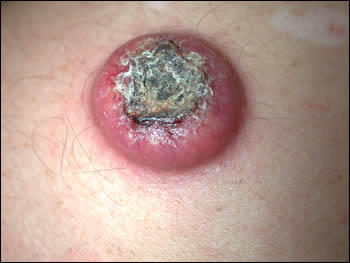Keratoacanthoma - skin cancer - treatment

Keratoacanthoma is a form of squamous cell carcinoma (SKIN CANCER) that appears suddenly and grows rapidly, though has a low rate of METASTASIS (spreading). Like other forms of skin CANCER, keratoacanthoma is the consequence of extensive sun exposure that manifests decades later. Researchers have identified a number of chromosomal abnormalities that appear connected with keratoacanthoma, suggesting a strong genetic component or familial predisposition (tendency of the cancer to run in families).
Most keratoacanthomas develop in people over age 50, though may occur at younger ages in people who are taking IMMUNOSUPPRESSIVE THERAPY (such as following ORGAN TRANSPLANTATION) or who are IMMUNOCOMPROMISED. A keratoacanthoma lesion typically develops on skin surfaces that receive or have received significant sun exposure and may initially appear to be a FURUNCLE (boil) or a cyst. The lesion often appears to heal, though seems to take a long time to do so (up to a year).
Keratoacanthoma Treatment
Though it appears that keratoacanthoma eventually resolves (heals) on its own, the risk that the lesion could instead be squamous cell carcinoma or that the keratoacanthoma could metastasize causes dermatologists to recommend immediate removal with microscopic examination to confirm the diagnosis. Keratoacanthomas tend to recur. The dermatologist may recommend surgical removal of the lesion or inject it with a chemotherapeutic agent, either of which generally is adequate treatment.
See also ACTINIC KERATOSIS; CANCER TREATMENT OPTIONS AND DECISIONS; SKIN SELF-EXAMINATION.